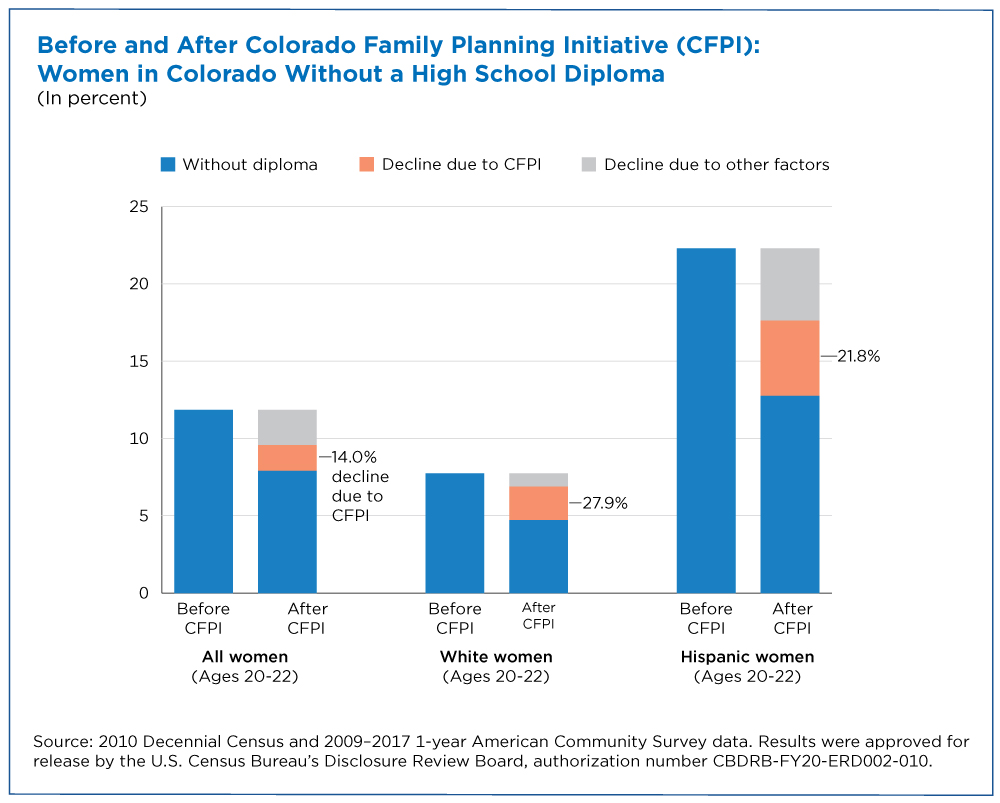New Census Bureau Research Shows Link Between Contraception Access and High School Completion
Does access to contraception impact women’s lives, including their educational attainment?
While the answer is often assumed to be “yes,” there is surprisingly little empirical evidence to support it primarily because of limited data availability.
This research is made possible because the Census Bureau is now allowing researchers access to linked decennial and ACS data at the individual level under strict privacy restrictions.
But now, a research team from the U.S. Census Bureau and the University of Colorado have filled the data void by linking decennial census data and American Community Survey (ACS) data to analyze the impact of the Colorado Family Planning Initiative (CFPI) on high school completion.
This research is made possible because the Census Bureau is now allowing researchers access to linked decennial and ACS data at the individual level under strict privacy restrictions.
Contraception and Education
In 2009, CFPI increased access to contraceptives by making every FDA-approved contraceptive method available to every client in every Colorado Title X family planning clinic at low or no cost.
The Census Bureau and University of Colorado research team found that since then, the CFPI program resulted in a 2% increase in high school graduation rates for young women and a 14% decrease in the proportion of young women in Colorado without a high school diploma.
The impact of CFPI on education for Hispanic women was especially large. Prior to CFPI, a greater share of Hispanic women were not graduating high school: 22.3% compared to 7.7% for non-Hispanic White women.
CFPI is estimated to have reduced the share of Hispanic women not graduating high school by 21.8% and significantly increased high school graduation rates for Hispanic women in Colorado by 2.1%.
The findings were recently published in a paper entitled, “The Impact of Contraceptive Access on High School Graduation.”
Benefits of Linking Large Data Sets
The research was made possible by linking the 2000 and 2010 decennial censuses to the ACS at the individual level. This created a large longitudinal data set to analyze the impacts of CFPI.
Without longitudinal data, it would not have been possible to identify the individuals in Colorado at the time of the policy implementation and track their educational outcomes.
Existing longitudinal surveys in the United States were not an option for this research because of small sample sizes. The linked 2000, 2010, and, soon-to-be-available 2020 decennial census data and large ACS sample data create opportunities to study programs like CFPI, which were not possible previously because of the limited availability of data.
How the Census Bureau Protects the Data
The Census Bureau links individual respondents across surveys and censuses. It does that by assigning unique anonymous identifiers based on Personally Identifying Information (PII) in the data. The Census Bureau then replaces most PII with a unique identifier before the data are used by employees and researchers.
Even without the PII, the data are accessed in a secure, restricted-use environment on approved projects for statistical and research purposes only. All results are reviewed prior to release to ensure the confidentiality of all respondents.
Prior to 2015, there were limited projects approved to link decennial census and ACS data for research. The Census Longitudinal Infrastructure Project pilot program was developed for 10 Census Bureau and academic research collaborations.
Following the success of these research projects, many of which are still ongoing, the Census Bureau started allowing researchers to request the linked decennial census and ACS data for use on research projects in 2018.
Researchers can now ask for access to decennial censuses and ACS data linked at the individual level for use on statistical projects. There is a standard research proposal process and once projects are approved, researchers access the restricted-use data through the Federal Statistical Research Data Center (FSRDC) network.
Researchers interested in using these data should contact the Census Bureau administrator at the FSRDC locations.
Katie Genadek is an economist at the U.S. Census Bureau.
Story Ideas and Statistics
Subscribe
Our email newsletter is sent out on the day we publish a story. Get an alert directly in your inbox to read, share and blog about our newest stories.
Contact our Public Information Office for media inquiries or interviews.
-
America Counts StoryBlack High School Attainment Nearly on Par With National AverageJune 10, 2020In recent years, Black educational attainment has been much closer to the national average: 88% have a high school diploma. Gaps remain in college attainment.
-
America Counts StoryAre Women Really Opting Out of Work After They Have Babies?August 19, 2019More than 80% of highly educated women who had a baby in the last 12 months were in the labor force, compared to about half of women with a high school degree.
-
America Counts StoryNumber of People With Master’s and Doctoral Degrees Doubles Since 2000February 21, 2019About 13.1 percent of U.S. adults had a master’s or doctoral degree in 2018, up from 8.6 percent in 2000.
-
Business and EconomyWhat Is the Nonemployer Marine Economy?April 09, 2025Thirty states had nonemployer businesses in marine economy sectors, including six states in the Midwest with receipts totaling nearly $11 billion in 2022.
-
Business and EconomyEconomic Census Geographic Area Statistics Data Now AvailableApril 07, 2025A new data visualization based on the 2022 Economic Census shows the changing business landscape of 19 economic sectors across the United States.
-
Income and PovertyWhat Sources of Income Do People Rely On?April 02, 2025A new interactive data tool shows income sources for hundreds of demographic and economic characteristic combinations.
-
Business and EconomyBig Improvements to the Annual Integrated Economic Survey (AIES)March 26, 2025The Census Bureau is making several changes and enhancements to capture 2024 economic data based on feedback from last year’s survey.








